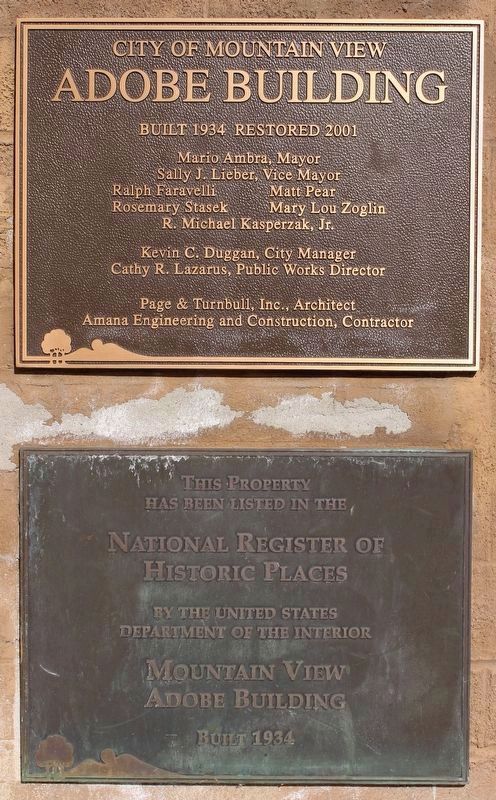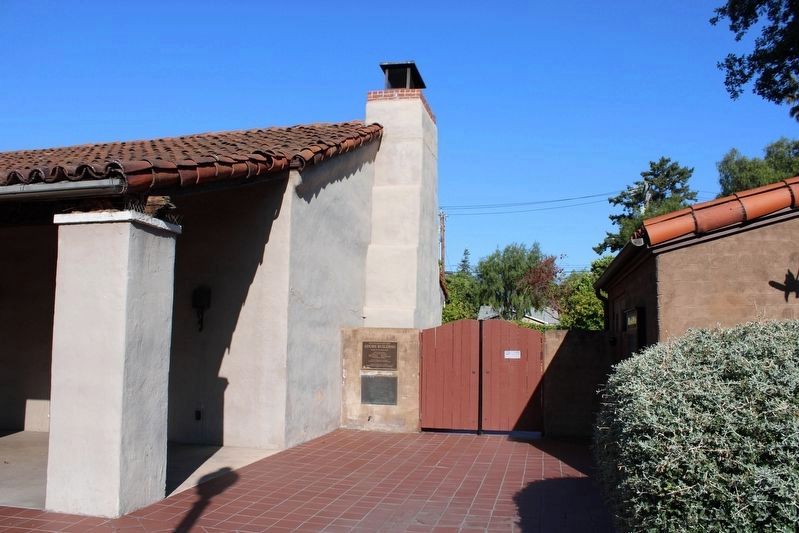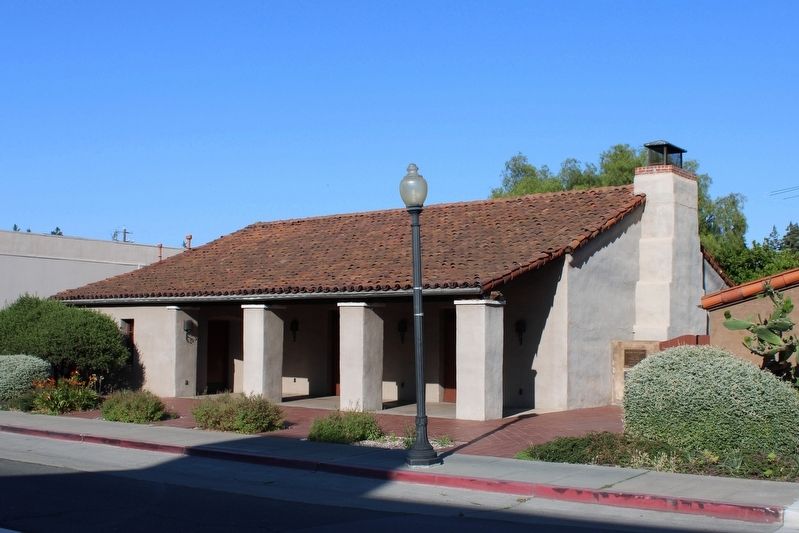Mountain View in Santa Clara County, California — The American West (Pacific Coastal)
City of Mountain View Adobe Building
Mario Ambra, Mayor Sally J. Lieber, Vice Mayor Ralph Faravelli Rosemary Stasek Matt Pear Mary Lou Zoglin R. Michael Kasperzak, Jr. Kevin C. Duggan, City Manager Cathy R. Lazarus, Public Works Director Page & Turnbull, Inc., Architect Amana Engineering and Construction, Contractor
Marker Two:
National Register of Historic Places
By the United States Department of the Interior
Mountain View Adobe Building
Built 1934
Erected by City of Mountain View.
Topics. This historical marker is listed in this topic list: Notable Buildings. A significant historical year for this entry is 1934.
Location. 37° 23.756′ N, 122° 4.636′ W. Marker is in Mountain View, California, in Santa Clara County. Marker is at the intersection of Moffett Boulevard and Central Expressway, on the right when traveling north on Moffett Boulevard. The plaques are mounted to the exterior of the chimney. Touch for map. Marker is at or near this postal address: 157 Moffett Boulevard, Mountain View CA 94043, United States of America. Touch for directions.
Other nearby markers. At least 8 other markers are within 2 miles of this marker, measured as the crow flies. The Mountain View Train Depot (about 400 feet away, measured in a direct line); NASA Ames Research Center (approx. 1.2 miles away); Mariano Castro Adobe (approx. 1.2 miles away); Site of the John W. Whisman Home (approx. 1.3 miles away); SPARC RISC Architecture (approx. 1.3 miles away); Online Systems and Personal Computing (approx. 1.3 miles away); First RISC Microprocessor (approx. 1.3 miles away); Shakey: The World's First Mobile Intelligent Robot (approx. 1.3 miles away). Touch for a list and map of all markers in Mountain View.
Regarding City of Mountain View Adobe Building. A notice posted across from the markers:
by Mark Rogge
FORWARD
The Mountain View Adobe, situated near the heart of the City, at 157 Moffett Boulevard and Central Expressway, is also near the hearts and minds of many residents. Few who live or work in Mountain View do not have a story to tell or at least an acquaintance with this unusual structure.
Built in 1934 during the Great Economic Depression, the building is a testament to those whose duty and service to their country had already been tested in World War I. While jobs and material were scarce, ingenuity and the will to succeed were expressed through the many "letter" agencies of the federal government's Works Progress Administration (CWA). One of those bureaus, the Civil Works Administration (CWA) provided jobs for out-of-work laborers in Mountain View. City Engineer Reinhoel designed a project to benefit the community and give purpose to the work of building adobe blocks.
Though records of this era are incomplete the legacy of the adobe building, and a wealth of information, collected by the Mountain View Historical Association and organized at the Public Library's History Center, provide interesting highlights to the history of the building and its people. These articles illustrate some of the more significant points.
An Overview
The Adobe Building first appears as an anomaly and an anachronism. Situated between commercial and residential neighborhoods beside the new light rail trolley and CalTrain at the edge of the Central Business District, the form and character of the building differs from its surroundings. The 1934 age of the building is also far too recent to be from Native American or Mission heritages. What makes the Adobe Building so significant historically and important culturally is part its secret and its charm.
The land at 157 Moffett was acquired for the City's water system. A well, pump station and large round reinforced concrete reservoir were installed in 1930 to serve the needs of a growing downtown. As Moffet Field was being commissioned to the north, a Community Center Building was contemplated at a proposed linkage between Castro Street with Moffett Boulevard. At the time Castro Street connected across the tracks with Stierlin Road, jogging northwest and continuing to what is now Shoreline Boulevard. Moffett Boulevard ended north of Central Avenue. Railroad Avenue ran across a portion of the current Central Expressway.
The Junior Chamber of Commerce worked with the City Engineer to obtain federal WPA funds to build a Mountain View Community Center. The resulting "adobe" building actually has a concrete foundation and slab, concrete columns and a continuous concrete beam surrounding the eaves and gables of the roof. The space between concrete columns is infilled with adobe blocks. The adobe blocks were also used as forms for the building's concrete columns; to build walls along the perimeter of the site; and to face the pump house building, made originally of simple wooden walls. City Engineer Reinhoel apparently designed the building following government publications of the era that suggested combining timeless materials such as concrete and adobe to build homes and small meeting halls. So, the building being neither original native adobe nor modern concrete, stands as an excellent example of 1930s concrete and adobe construction, using local vernacular elements to create a memorable and functional Spanish Revival style community building.
Although we tend to dwell on the adobe of its namesake, other elements are splendid. Hand hewn lumber is joined with wrought iron to create a high open-truss ceiling, clad with decorative wood panels. The handmade tapering arched clay tiles on the roof were added in 1935. The community raised money to replace the original composite roof with clay tiles that were originally planned and were deleted due to lack of funds.
The floorplan of the Adobe Building follows a simple adobe style with a generous covered front porch, leading directly into the Great Room, then out to a garden with a proportionally smaller rear or garden porch. The Great Room leads directly to restrooms, a large kitchen and an office as well as to exterior doors without hallways. This efficiency of space and material along with the simplicity of ornamentation is a hallmark of the beauty of this design.
Also see . . . National Register of Historic Places Registration Form.
"The Mountain View Adobe is located on land that in the late 1920s was occupied by a city reservoir. In 1929, Wallace and Alice Angelo deeded the city the site for ten dollars and the next year the city built a water well, pump and reservoir on a portion of the site south of where the Mountain View Adobe stands. In 1930, a simple frame pump station building was built over the well. This reservoir became the main water source for the city of Mountain View. In the 1930s the need for a community building prompted the city to consider the reservoir site. In 1934,construction began on the community center located next to the reservoir and pumphouse. When the Mountain View Adobe was built, the pumphouse was given a layer of adobe block to harmonize it with the larger building. The Mountain View Adobe was designed by City Engineer Don Reinhoel and funded with $1,100 worth of bonds issued by the Junior Chamber of Commerce. The project was meant to both provide the city with a meeting place and to provide employment during the Depression."(Submitted on September 3, 2023, by Joseph Alvarado of Livermore, California.)
Credits. This page was last revised on September 3, 2023. It was originally submitted on September 3, 2023, by Joseph Alvarado of Livermore, California. This page has been viewed 88 times since then and 25 times this year. Photos: 1, 2, 3. submitted on September 3, 2023, by Joseph Alvarado of Livermore, California.


